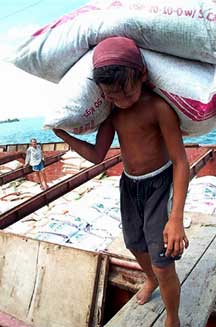Special Report
Tender
hands that toil
Rising Incidence of Child Labor in Negros
First of three parts
Some 200 children usually gather daily and sit at the yard of the Bacolod
City Reclamation Port. It is however neither the sea birds nor impressive
sunset that bring smiles on their faces. Rather, it is the arrival of
domestic and foreign cargo ships which, to them, means food on the table.
When the ships are gone, the children go back to waiting, uncertain where
their next meal would come.
BY Karl G. Ombion
Bulatlat
|
BACOLOD
CITY - Children work for many reasons, the most prevalent reason being
poverty. Though their incomes do not suffice to meet even their personal
needs, they still serve as regular contributors to the family income.
There are many people though, especially among the rural poor, who do not
see anything wrong with child labor because of the pervasive thinking that
work is integral to the child’s development. In fact, it is also a widely
accepted view that children, young as they are, must help for the
family’s survival.
Rising number
Based on the 2000 survey of the International Labor Organization (ILO) and
National Statistics Office (NSO) and studies by the Bacolod-based research
group Center for Investigative Research and Multimedia Services (CIRMS),
around four million or 16.2 percent of the 24.9 million Filipino children
(aged five to 17 years) work.
|

Child stevedore
Photo courtesy of CIRMS |
This reflects a significant increase from the 1995 ILO and NSO surveys
wherein 3.6 million child workers were documented. The age group of 10-14
years accounted for 48 percent of the working children while the age group
of 15-17 years accounted for 46 percent.
There were more child male workers than child female workers. The gender
ratio showed 173 male child workers for every 100 child female workers.
Based on geographic distribution, about 70 percent child laborers were
found in rural areas and only 30 percent in urban areas. Urban-based child
workers were a little older than their rural counterparts: the average age
of urban-based child workers is 15 while the rural average age is 14.
Child labor in
Negros
The regions
with the highest incidence of child labor are: Southern Tagalog or Region
IV (11.5 percent),
Central
Visayas
or Region VII (9.7 percent), Eastern Visayas or Region VIII (8.7 percent),
Bicol or Region V (8.6 percent), Southern Mindanao or Region XI (8.5
percent) and Negros-Panay or Region VI (7.9 percent).
For
Negrenses, the incidence of child labor has reached alarming proportions.
In 2000, there were only around 300,000 working children (aged five to 17
years) out of the 831,542 children in
Negros.
The CIRMS study reveals that as of end 2004, the number of child workers
in Negros has already reached 334,405. This means a 4 percent increase or
an average of 8,600 new child workers every year.
In the entire region, male children (51 percent) are 2 percent ahead of
their female counterpart (49 percent). The gender ratio in the region is
103 male child workers for every 100 female child workers.
Concentrations
Nearly 15 percent of Negros Occidental’s working children are in the
capital city of Bacolod. The rest are in the northern cities of
Cadiz
(5.61 percent),
Sagay City (5.18 percent), San Carlos City (4.88 percent), Silay City
(3.89 percent), Escalante City (3.18 percent) and Calatrava (3.18 per
cent). In the south, they are mostly in Kabankalan City (6.34 percent),
Bago City (5.53 percent) and Himamaylan (3.63 percent).
The higher child labor incidence in northern
Negros
is mainly because of the presence of sugar plantations that employ
children farm workers.
Meanwhile,
the
province
of
Negros Oriental registered the highest number of child labor incidence at
197,283, compared to Negros Occidental’s 137,122. This means one in every
two children aged 5-17 in Negros Oriental is a child worker. Based on the
projected provincial population for 2004 of 1,258,064, almost 32 percent
(397,283) are children 5-17 years old. Of this number, almost half (49.78
percent) work.
The number of
working children in Negros Oriental significantly increased to 197,778
based on 2004 projected provincial population. They are mostly found in
two major cities of the province, namely, Dumaguete (9.08 percent) and
Bayawan (9 percent). The municipalities with high numbers of child workers
are Guihulngan (7.41 percent), Tanjay (6.23 percent), Bais (6.04 percent),
Sta. Catalina (5.97 percent), Mabinay (5.72 percent) and Siaton (5.71
percent).
Rural-based
CIRMS reveals
that 64 percent of
Negros’ working
children are rural-based. Majority or 26 percent are “employed” in sugar
plantations engaged in weeding, plowing, cane cutting, fertilizing and
hauling during harvest season. Fourteen percent on the other hand work in
rice, corn, orchard farms; 11 percent in commercial fishing as helpers and
divers in trawls, haul boats, fishing boats and fishponds; 3 percent in
various rural odd jobs like charcoal making, woodcutting, vending,
small-scale mining and helper in public utility jeepneys; and 1 percent in
domestic work.
Meanwhile,
36 percent are urban-based working children. Of these, majority are in
street vending (fish, food and similar items). The rest are in pedicab
driving, domestic work, scavenging and various odd jobs, such as in small
eateries (dishwashing, cleaning and errand work); commercial ports (kargador
or pier workhand); bus/jeep terminals (as baggage hauler, dispatcher and
conductor); pyrotechnics (firecrackers making); and small handicrafts (as
helpers, cleaners and errand boys/girls). A small percentage is in the sex
trade (pub houses and prostitution dens) and entertainment industry
(showbiz, fiestas and public shows). Bulatlat
Related articles:
Tender hands that toil
Unprotected by
Government
Second of three parts
Tender hands that toil
Children Stories
Last
of three parts
BACK TO
TOP ■
PRINTER-FRIENDLY VERSION ■
COMMENT
© 2004 Bulatlat
■
Alipato Publications
Permission is granted to reprint or redistribute this article, provided
its author/s and Bulatlat are properly credited and notified.